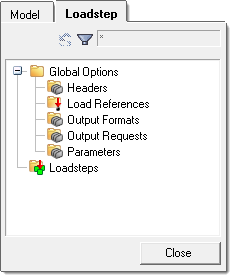Loadsteps Browser: OptiStruct & Nastran Profiles |

|

|

|

|
|
Loadsteps Browser: OptiStruct & Nastran Profiles |

|

|

|

|
The browser’s tree structure lists relevant control cards and loadstep information, organized into folders.

There are many functions available, accessed by right-clicking on the tree background or on individual or multiple items. For the OptiStruct and Nastran profiles, these options include:
Function |
Description |
New loadstep |
Create a new loadstep, either from scratch or by creating an exact copy of an existing loadstep. |
Edit options |
Depending on the entity selected, this will bring up an appropriate GUI for editing of the loadstep or control card information. |
Edit card |
Review the selected entity in the HM card editor. |
Delete |
Delete the selected entity or entities. |
Rename |
Rename the selected entity. |
Renumber |
Renumber the selected entity. |
Summary table |
Generates a summary table of the selected loadsteps. |
Contour Loads |
This launches the Contour Loads utility and automatically selects the loadcols associated with the selected loadstep. |
Loads Summary |
This launches the Loads Summary utility and automatically selects the loadcols associated with the selected loadstep. |
Collapse all/selection |
Collapses all selected folders and subfolders, or all folders if none are selected. |
Expand all/selection |
Expands all selected folders and subfolders, or all folders if none are selected. |
Auto-manage load references |
This option is for users who wish to have existing DLOAD, LOAD, MLOAD, MOTION, MPCADD and SPCADD cards auto-managed. This option creates a copy of loadcols with these card images and converts them into an auto-managed naming convention for easy editing/reviewing inside the Edit options popup. |
OptiStruct |
Opens the OptiStruct panel in HyperMesh. |
In addition, every loadstep listed in the tree has a small checkbox next to it as well as an export state indicator. You can click these to toggle them back and forth:
|
The loadcols in the loadstep display in the HyperMesh graphics area. |
|
The loadcols in the loadstep do not display in the HyperMesh graphics area. |
|
This loadstep will not be exported. |
|
This loadstep will be exported. |
|
How do I…
A pop-up window opens, allowing you to:
Another pop-up window opens, allowing you to edit the loadstep.
|
A popup window opens, allowing you to edit the loadstep. The popup has several tabs to gather the relevant information.
Depending on the Loadstep Type, the list of appropriate Load References will change accordingly. A tree structure lists the load references that are available for the selected loadstep type.
Alternatively, click cancel to close the window, discarding your changes.
CommentsYou can also edit multiple loadsteps simultaneously by selecting more than one loadstep in the browser (such as by shift-clicking) before you choose edit options from the right-click menu.
Any edits you make will be applied equally to all of the selected loadsteps. Any values that are checked "off" will not be modified, but options checked "on" will all be set to the same values. |
|
|
Editing Global Options works exactly like editing a loadstep, except that the first step is to right-click the Global Options folder or any of its sub-folders, instead of clicking on a specific loadstep’s folder or sub-folder.
|